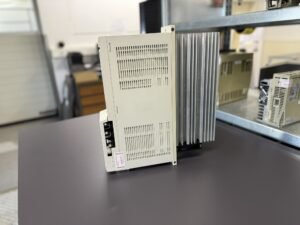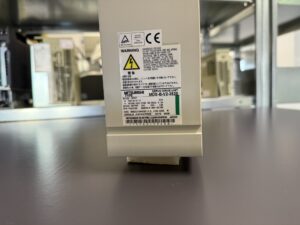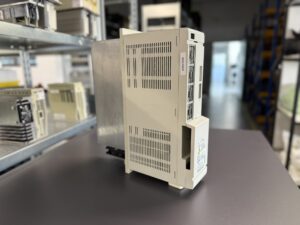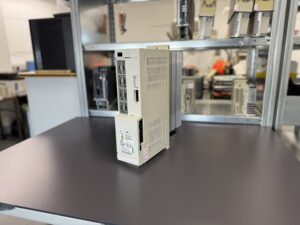27.08.2025 by Viktor Siebert
Mitsubishi Servo Drive Unit MDS-B-V2-3520 – Technical Analysis and Repair Experience
When the Mitsubishi Servo Drive Unit MDS-B-V2-3520 arrived at our workshop, it was immediately clear that someone else had worked on it before. Screws bore marks, components had been replaced and yet it seemed as if someone had swapped parts at random, without any clear concept or diagnosis. Almost as if they had been changing components blindly, hoping the problem would disappear.
We mounted the unit into our test bench. At first, everything looked fine: no alarms, no irregularities, the device seemed to be running smoothly. For a moment, it almost looked like the competitor’s repair had been successful. But experience has taught us that the most dangerous faults are often the ones that don’t show up immediately.
After speaking with the customer, the picture became much clearer. He explained that the device always failed after a certain period of machining especially when processing larger workpieces. For smaller parts, however, everything worked fine. As a test, he had swapped the amplifier with a similar one from another machine and the problem disappeared. That confirmed without a doubt that the fault was within the returned drive.
To make matters worse, the customer was already in conflict with the previous service provider. Understandably, he did not want to pay for a repair that had not actually fixed the problem. But proving it was difficult, since the fault did not occur immediately but only after extended operation. This is exactly where a professional test environment makes all the difference.
We decided to test the unit under real load conditions. On our test bench, we don’t just check devices for a short moment; we simulate real production thermal stress, fluctuating loads, and continuous operation. And indeed: after about ten minutes, the fault appeared. The device overheated and repeatedly shut down with Alarm 32 Power Module Overcurrent. The error was reproducible and we documented it clearly in our test logs.
The diagnosis was clear: there was a problem in the power module. The previously replaced components were not properly chosen or installed. The IGBT transistor module in particular turned out to be critical.
We followed a systematic repair process:
- Complete disassembly and cleaning removing dust and old thermal compound residues.
- Preventive replacement of all components in the power section – not only defective ones but also the parts that had already been replaced, to eliminate any uncertainty.
- Renewal of the IGBT transistor module, matched carefully with suitable drivers and capacitors.
- Inspection of the control board for cold solder joints and memory components.
- Thermal endurance testing for several hours with load variations and full documentation of all measured values.
The result was clear: after the overhaul, the device ran stably and without further failures.
For us, this repair was more than just a technical intervention. It demonstrates how crucial thorough analysis and realistic testing are. Had we relied only on a short functional check, the drive might have been returned as “repaired” but the customer would still have faced production downtime.
In the end, the customer was able to put his machine back into reliable operation. At the same time, he had the certainty that not only the obvious fault had been fixed but the entire power section had been overhauled preventively. That kind of reliability is invaluable and it is what makes the difference between a quick part swap and a truly professional repair.




To mentioned Mitsubishi Drive: Mitsubishi MDS-B-V2-3520 Servo Drive
More details about our Mitsubishi repair services can be found here:
Mitsubishi drive Repair by Industrypart
📞 Feel free to contact us with any questions about your Mitsubishi drive technology.
Our expert team is happy to help!
Technical Specifications
| Item | Specification |
|---|
| Model | MDS-B-V2-3520 |
| Series / Type | MDS-B, V2 = 2-axis servo amplifier |
| Power Supply | DC link (main supply) + separate AC control power |
| Rated Input DC | DC 270–311 V, 31 A |
| Rated Input AC | AC 200–230 V, 50/60 Hz, 2 A |
| Axis Output 1 | 16 A (Servo Axis 1) |
| Axis Output 2 | 13 A (Servo Axis 2) |
| Hardware Version | H/W VER M |
| Date Code | 9905 (May 1999) |
| Manufacturer | Mitsubishi Electric Corporation, Japan |
Application Environment & Compatible Machines
The MDS-B-V2-3520 is used in CNC machines from Mitsubishi, Mazak, DMG Mori, OKK, Hitachi Seiki, and comparable machine tool manufacturers. Typical applications include:
- Tool changers
- Linear axes (X/Y/Z)
- Feed drives in turning and milling machines
- High-precision machining of metals and plastics
Operating environment:
- Temperature: 0–55 °C
- Humidity: < 90 %
- Dust-free, dry environment with sufficient cooling
Functional Description
The device is a 2-axis servo amplifier from the Mitsubishi MDS-B series. It controls servo motors with high precision, continuously monitoring position, torque, and speed, while ensuring safe shutdown in case of errors.
Key functions:
- Power regulation via IGBT modules
- Communication with CNC control through optical interfaces
- Internal diagnostic and protection functions
- Monitoring of temperature, overcurrent, and overvoltage
Alarms and Troubleshooting
| Alarm | Meaning | Possible Cause | Solution |
|---|
| 12 ME | Memory Error | SRAM/FLROM memory fault | Check control board, replace if needed |
| 13 SWE | Software Processing Error | CPU processing fault | Restart, replace control board |
| 1B SCPU | CPU Error (SUB) | EEPROM data error in encoder | Check encoder or control board |
| 20 NS1 | No Signal Detected | Missing feedback signal motor/encoder | Inspect encoder, cabling, signal path |
| 25 ABSE | Absolute Position Error | Absolute encoder data invalid | Reinitialize absolute encoder |
| 32 POW | Power Module Overcurrent | Overcurrent in power module | Inspect/replace power stage |
| 3A OC | Overcurrent | Overcurrent in motor circuit | Check motor and cabling |
| 3B PMOH | Power Module Overheat | Power section overheating | Check cooling, fans, replace module |
| 40 OHM | Motor Overheat | Motor temperature too high | Inspect motor and cooling system |
| 46 OL1 | Overload 1 | Continuous overload | Check mechanical load and machine setup |
Components
| Name | Designation on PCB | Quantity |
|---|
| Control Board | RK111C / BN638B306G51 or RK111B-12 / BN634A815G51 D | 1 |
| Power Board | RK122B-V2-3535 or RK122C-V2-3535 | 1 |
| Power Module | Power section | 1 |